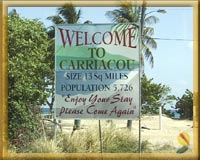 |
|
 |
|
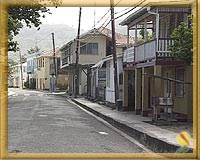 |
|
A
warm welcome is assured |
|
Lauriston
Airport |
|
Hillsborough
main street |
|
Carriacou
is the largest of the group of islands known as the
Grenadines, which lie scattered between
St Vincent and
Grenada. It is
part of the independent tri-island nation of Grenada, Carriacou and
Petit Martinique, and is 23 miles northeast of Grenada at 12 28' N, 61
28' W. Hillsborough, the only town, is the port of entry, and there
are also several small villages scattered throughout the island. Carriacouans are industrious and most are self-employed,
announcing their services in hand-lettered signs: They fix tyres,
make furniture, print menus, shoot passport photos, straighten
ladies' hair, and record music, all in the span of just a couple
of streets. The island's architecture shows both whimsy and
practicality and says a lot about island life. Hand-sawn
fretwork and hand-chipped stone embellish simple houses whose
jalousied or glassless windows let in the cool trade winds.
Planters, recycled from plastic buckets, trim cottage stoops,
and front yards are furrowed into rows of corn and pigeon peas.
Though many of the islanders don't have much in terms of
material goods, they express well-being. You will see babies
delighting in their morning sea bath, men playing earnest games
of soccer on the beach, and night-time gatherings at the
crossroads for conversation.
Hillsborough,
Carriacou's one town, has an unprepossessing Main Street: some
storefronts are empty, paint is peeling on others. But take a
closer look and you will see its history in the stone and
shingled buildings, balconied second floors, and the beautiful,
dressed-stone remains of a lime warehouse, being carefully and
conscientiously salvaged in an overgrown lot.
An impressive number
of Amerindian artefacts have been found here, (a few years ago a
dig in Harvey Vale uncovered several complete human skeletons,
burial masks, a drinking well and other remnants leading
speculation toward a 1,000+ year old Taino site) including
ceramic body ornaments and loom weights.
Roads built by the
French in the seventeenth century, now bowered by overreaching
trees, crisscross the island and make wonderful walking trails.
Summer Year 2001 was the reconstruction of the major commercial
road network island wide. Until its completion we had patience
and endurance as the old roads were removed and replaced with
concrete. The cotton, sugar, and indigo plantations established
by the English in the 1700s and 1800s may be long gone, but
there still remain their great houses and outbuildings (in
various stages of repair) in cow pastures and trackless
woodlands.
|
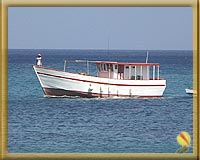 |
|
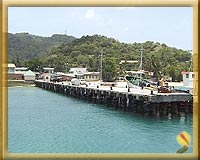 |
|
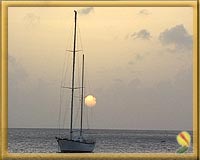 |
|
Unique
Carriacou boats |
|
Hillsborough
Harbour |
|
A
mecca for cruising yachts |
|
Carriacou is a volcanic island surrounded by coral reefs. 7 miles
long, 3 miles wide, with a central ridge of some 300 feet and two high
points of approximately 955 feet. The island is sparsely developed
(pop. 6000 in 13 sq miles). There are many original chattel houses and
some plantation ruins with old windmills and mellow stonework against
a backdrop of the Caribbean Sea or the Atlantic Ocean.
Carriacouans also like to celebrate: "Fisherman's Birthday" is
a once-a-year, three day fête at which everyone seems to join in
the swimming races, tug-of-war, domino games, and dancing. For
Carnival, villagers competitively recite Shakespeare, and at
weddings, four-piece bands play for intricate quadrilles which
spouse will dominate. Even a foreboding dream may be a cause for a
festival: To avoid a drastic event a "Maroon" is held with "smoke
food," hymns, and the playing of Big Drums.
Nonetheless, Carriacou is on most days a quiet place where you
get up with the sun and go to bed with the moon's rising. Time has
no meaning; thermometers do not exist. Cows cool themselves on the
beach and braying donkeys graze at roadsides, and though Canute
Caliste's naive paintings have been internationally recognised, he
is proudest of his 23 children and more than 200 grandchildren.
Even with just a little over 100 "beds" on the island,
Carriacou has an astonishing range of accommodations, from plain
guesthouses with shared facilities to airy mountainside suites to
private cottages and villas. Simplicity, however, is the order of
the day: Closets are routinely minute, soap is the only amenity,
showers are most often without temperature controls.
|
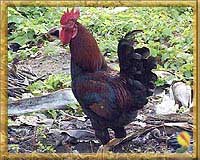 |
|
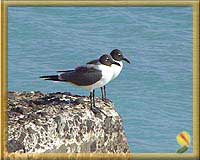 |
|
 |
|
A
naturalists dream come true |
|
It is not uncommon to see donkeys , or a hen with her chicks, in Main
Street. Once out of the tiny town, huge tracts of wooded hills drop
down to near deserted coastlines. Beaches range from volcanic black in
places to the purest white on the many easily accessible sandbanks and
uninhabited out-islands. Eastern beaches have a deserted and abandoned
atmosphere with twisted, sea-whitened tree trunks and ancient
graveyards. Western beaches are softer and have traditional fishing
boat and schooner activity among the shoreline palms. The out-islands
of White and Sandy offer 'desert island' shooting at its best, with
some of the finest water colours to be found in the world.
Carriacou's obvious attractions are the gorgeous waters -
clear, warm, with white-sand seafloors, and there are always local
boat operators willing to take you to the many nearby, uninhabited
off-islands if you have already taken the time to explore the
beaches around the island itself. The close-in reefs abound with
fairy basslets and stoplight parrotfish, even queen triggerfishes
and schools of squid. Extensive coral beds that a snorkeller can
reach from the beach provide hours of enjoyment. Explore the
island and find the Santa Maria trees whose fragrant leaves are
used in herbal remedies. Walk the often sylvan roads and trails.
Greet the women in their gardens, children wheeling hand-made
toys, young men playing soccer in the road. Always take plenty of
water and don't pass-up one of the 100 rum shops where you can get
- besides rum and conversation - beer and sodas.
|
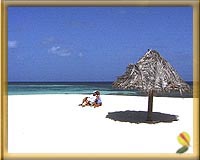 |
|
 |
|
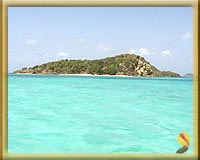 |
|
Making
the films of the Islands is such hard work |
|
Carriacou has perhaps a
dozen restaurants but a multitude of eating establishments.
However, daily research is required: Stop by the restaurants,
bars, and rum shops. Ask what they are cooking that day, for even
in season what you see on the menu is not necessarily what you'll
be offered - menus merely suggest the range of the cook's skills.
Since they rely on fresh foods, their repertoire is determined by
availability. Most, if not all produce is imported from Grenada,
St. Vincent or Trinidad, so don't expect California-size salads.
But the fish is always wonderful -- usually two or three kinds,
almost always including the local specialty lambi, or conch, or
lobster when in season (after 1 September).
History: From the many discoveries on Carriacou of
pottery and tools, it is known that around 1000 AD. Arawaks, followed
by Caribs, both from South America, settled on the island. The
earliest written records go back to 1656 when the name was spelt
Kayryouacou, originating, it is believed, from the Carib meaning
"land surrounded by reef".
 |
Carriacou was settled by the French, but in 1763 was ceded with
Grenada to the British. The majority of the inhabitants today are of
African descent, with the influence in the island mainly British, such
as driving on the left, though French names are still noticed,
especially in the L'Esterre area. The village of Windward was home to
a group of Scottish boat builders who settled here in the 19th century. |
|
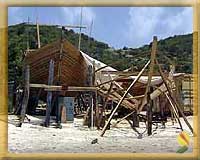 |
The Scottish names and boat building skills have been passed down
through the generations. Many locally built boats from small fishing
sloops to large trading schooners are seen in the Carriacou waters.
Boat building is still carried out in the traditional way on the
beaches but fewer have been built in recent years. In former times Carriacou produced mostly cotton with some sugar,
limes, coffee and cocoa. Today the inhabitants grow corn and pigeon
peas for their own consumption and subsistence farming, live stock
rearing, fishing and seafaring form the main occupations.
At 955 feet
above sea level, High Point North is the highest point in
Carriacou. This national park encompasses the complete spectrum
of ecological systems in Carriacou. It includes L’Anse La Roche,
the most scenic and private beach in Carriacou, where coral
reefs and outstanding volcanic and uplifted sedimentary
formations are clearly visible. The littoral vegetation of sea
grape, manchineel and coconut is well developed. The park is the
most undisturbed area of Carriacou.
Carriacou Fossil Beds: The fossil beds at Grand Bay are The only known beds in the
country which are plainly visible. They provide excellent
information, exposing millions of years of archaeology in the rock
layers including prehistoric shellfish, some of which are long
since extinct. Shore birds can be seen searching for crustaceans
in the mudflats of the lagoon. The adjacent coral reefs are
unquestionably this nations finest. Panoramic views of the reefs
may be seen from various lookout points on both Saline and White
Island.
Belair National
Park offers fabulous views over the north of the island and beyond
Petite Martinique.
Belair also has old French and English ruins
and the finest sugar mill and windmill foundations on the island.
Sandy Island Marine Park:
Surrounded by white sands, this tiny island has the
most spectacular coral reef, the home of shoals of variegated
tropical fish, in clear blue water. Ideal for picnics, this
beautiful island has been used for television and magazine
advertisements.
Saline Island and White Island Marine Park
present
examples of fascinating geology. Columnar jointing of the rock
formations indicate major volcanic activity. Saline Island has a
brackish lagoon salt pond surrounded by a mangrove ecosystem.
White Island is a marine park because of its virgin reefs, and
shoals of exotic tropical fish.
Petit Carenage
Bay: The mangrove ecosystems at Petit Carenage Bay are among the
most developed in country. Both the mangrove swamp formation and
littoral sand beach vegetation are found. This is one of the
finest mangrove and mud flat ecosystems. Here numerous migratory
and shorebirds can be found. The area is one of the best
bird-watching spots in the country.
Tyrell Bay: At
Tyrell Bay ‘tree oysters’ grow on mangrove roots. The oyster beds
can be visited by boat, and the trail back to L’Esterre is
spectacular with wonderful views.
Underwater Study:
The introduction of the ‘Carriacou Islander’, a 35 foot motor
powered catamaran, has opened exciting new possibilities for both
Carriacou and Petite Martinique. The 16 x 4 feet underwater
observation window, which can be raised and lowered as required
has the double advantage of allowing very close views of the
tropical reef and fishes while avoiding possible damage to this
fragile ecosystem. There is a library and running commentary,
which provides study opportunities for those with a special
interest in marine life.
|
|